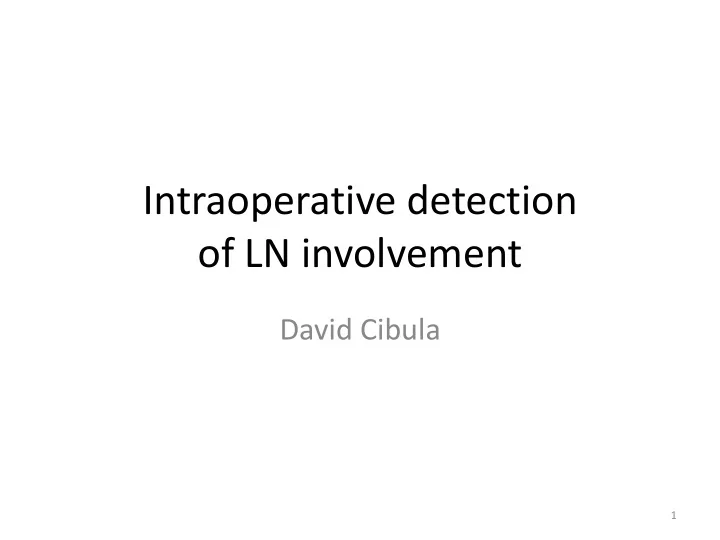

Intraoperative detection of LN involvement David Cibula 1
New ESGO/ESTRO/ESP guidelines T1b1/T2a SLN (LN) FS (S)LN neg or not done LN pos (MAC or MIC) PLND + RH ± PALND RH abandoned No further LN dissection Final histology CRT
ESGO survey: What is your management if pelvic LN involvement is detected during surgery? 2) Radical hysterectomy Abandoned Completed as planned Completed but radicality increased Completed but radicality decreased N/A 3
Stage IB-IIA (N=242) RH abandoned ( N=23 ) – grossly involved LN (all received CRT) RH completed (N=35) - LN positive from final histology Completed Abandoned 2yDFS 93% 59% P=0.01 IJGC, 2005, 498-502 4
SEER database, 1988 – 1998 Stage IB; N=3116 Criteria: LN pos. + PLND + PALND performed RH completed (N= 163) ( all adjuvant RT ) RH abandoned ( N=53 ) Completed Abandoned Median FU 6.42y 5.75y 5yOS 69% 71% Gynecol Oncol 2008,109,43-48 5
Stage IA2-IIA, N=268 RH abandoned ( N=19 ) grossly involved LN (84%) or pelvic spread (16%) RH completed (N=249) Completed Abandoned P RR 18% 37% 0.168 OS 80% 73% 0.772 Obstet Gynecol Int, 2010 6
Gross LN intraoperative involvement Single institution (USA) N=41 15 RH abandoned 26 RH + PLND 11 EBRT 8 EBRT+BRT All EBRT + BRT Completed Abandoned P Local RR 12% 27% 0.39 Distant RR 19% 33% 0.45 PFS 75 mo 47 mo 0.106 OS 92 mo 70 mo 0.886 Gynecol Oncol 2012, 69-72 7
RHL (N=89) – RH, PLND + adjuv. (C)RT CRT ( N=32 ) – RH abandoned + CRT Balanced age, FU, FIGO stage, histology RR 16% vs 31% P=0.073 Pelvic RR 2% vs 16% P=0.014 DFS 81% vs 67% P=0.024 OS 84% vs 77% P=0.298 Limitations Size of the groups Selection bias RHL – LN+ identified from final pathology CRT – LN+ identified intraoperatively Type of mets not analyzed IJGC, 2017, 27, 1015-1020 8
Conclusions • No evidence of superiority of one over the other approach • Obvious limitations of available literature small series innapropriate control groups • Limited data on morbidity 9
ENGOT-Cx3/CEEGOG/ABRAX Reasons to abandon ➢ Avoidance of morbidity related to radical hysterectomy itself ➢ Lower morbidity related to combined treatment ➢ Better oncological outcome due to the possibility of using brachytherapy 10
ENGOT-Cx3/CEEGOG/ABRAX Reasons to abandon Reasons to complete ➢ Avoidance of morbidity related to ➢ Lower risk of central pelvis recurrence radical hysterectomy itself (especially in larger tumours or adenocarcinomas) ➢ Lower morbidity related to combined ➢ Lower morbidity due to the avoidance treatment of brachytherapy ➢ Better oncological outcome due to the possibility of using brachytherapy 11
ENGOT-Cx3/CEEGOG/ABRAX Oncological outcome after completing or abandoning (radical) hysterectomy in patients with cervical cancer and intraoperative LN positivity ABRAX (ABandoning RAd hyst in cerviX cancer) Retrospective cohort study 12
ENGOT-Cx3/CEEGOG/ABRAX Objectives 1) To determine if the performance of radical hysterectomy improves oncological outcome in patients with intraoperative detection of LN involvement (comparing to radio(chemo)therapy alone) 2) Compare the prevalence of ≥ G2 treatment -related morbidity between the group with or without radical hysterectomy 3) Evaluate if the survival benefit of radical hysterectomy is modified by prognostic parameters (tumour size, histological type, type of metastases, presence of LVSI, number of involved LN) 13
ENGOT-Cx3/CEEGOG/ABRAX Inclusion criteria ✓ Histologically confirmed squamous cell carcinoma, adenocarcinoma, adenosquamous carcinoma ✓ Stage pT1a – pT2b ✓ Patient referred for primary surgical treatment (neoadjuvant chemotherapy is not an exclusion criteria) intended to perform LN staging followed by radical / simple hysterectomy or fertility-sparing procedure (FST) ✓ Intraoperative detection of LN involvement (any type of metastasis): o Macroscopic involvement = grossly involved lymph nodes (if confirmed by final pathology) OR o Microscopic involvement = SLN / LN intraoperative pathologic evaluation (frozen section) ✓ Follow- up data available for ≥ 2 years ✓ Surgery performed between January 2005 and December 2015 14
Period January 2005 – December 2015 Invasive cervical cancer (squamous cell carcinoma, adenocarcinoma, adenosquamous carcinoma) Stage pT1a-pT2b No grossly involved LNs on preoperative staging Scheduled for primary radical surgery including RH (or SH or FST) in combination with LN staging Excluded: Other histological types Surgery not performed Grossly involved LN on imaging Intraoperative detection of LN involvement Either grossly involved LN (if confirmed by final pathology) OR positive SLN / LN on intraoperative pathology assessment Excluded: Negative pelvic LN Intraoperative suspicion of LN involvement not confirmed by final pathology Uterine procedure (RH or SH or FST) completed or abandoned (PLND completed or not, PALND performed or not) Follow-up data for at least 2 years available Excluded: Follow-up data not available Or for < 2 years Group eligible for ABRAX trial 15
Our management LN Grossly enlarged FS (US) Neg Pos PALND 16
Our management LN Grossly enlarged FS (US) Neg Pos PALND Tumor size Patient´s preference RH abandoned RH (B) 17
Open Q ✓ type of LN positivity (grossly involved, microscopic) ✓ modern pre-operative imaging ✓ subgroups (large tumor size; adenocarcinoma) ✓ hysterectomy x PLND x PALND ✓ type of surgery (simple hyst x rad hyst) 18
Recommend
More recommend